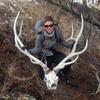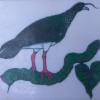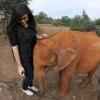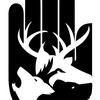Human-wildlife conflict and coexistence is a shockingly common problem, often with enormous consequences for both individual animals and entire populations.
When human-wildlife conflict comes to mind, you may immediately think of wildlife crime instead - which isn't wrong, since many regions with wildlife crime problems like poaching are also areas where people may frequently deal with human-wildlife conflict, causing the two issues to go hand-in-hand. But human-wildlife conflict is a much broader issue encompassing many ways that human presence and interference can cause problems for us and animals alike. Human-wildlife conflict includes:
- Elephants trampling a farmer's crops, resulting in retaliation
- New real estate developments infringing on ecosystems where predator species live, leading to predators having less territory and less food, which in turn leads to predators attacking domestic animals and livestock
- Freeways dividing the territory of animals like mountain lions, leading to wildlife venturing into neighborhoods or being killed by cars
- Lead bullets used in hunting causing scavengers like condors to die of lead poisoning
These are just a few examples of how humans can negatively impact wildlife, and it's clear to see how many of these scenarios could escalate. Human-wildlife conflict solutions don't just include ways in which we can prevent these issues (for example, through tracking predators, monitoring populations' territories, or building barriers and wildlife crossings monitored by sensors), but also the ways in which we can help people connect with wildlife and care about learning to live alongside them.
If you're interested in solutions that can prevent human-wildlife conflict, join this group and get to know the people who are working to protect and save species around the world!
Header image: Casey Allen on Unsplash
No showcases have been added to this group yet.
- @georg_strunck
- | he/him
Delft University of Technology & SPOTS | Strategic Protection Of Threatened Species
MSc Student in Aerospace/Robotics @TU_Delft | Engineer & Project Manager @StrategicProtectionOfThreatenedSpecies (SPOTS) | Robotics Engineer @BiodivX with @ETH Zürich for the xPrize rainforest competition

- 1 Resources
- 9 Discussions
- 10 Groups
- @KB
- | she/her
Wildlife ecologist specializing in animal movement modeling and habitat selection with a strong interest in conservation policy and management decisions.
- 0 Resources
- 0 Discussions
- 17 Groups
- @vfhawkinson
- | she/her
University of Washington
PhD student assessing multi-scalar livestock-wildlife interactions in the American West
- 0 Resources
- 1 Discussions
- 8 Groups
- @trish_lai
- | she/her
UCD SVM Student
- 0 Resources
- 0 Discussions
- 11 Groups
- 0 Resources
- 0 Discussions
- 3 Groups
- @emcandler
- | she/her
- 0 Resources
- 0 Discussions
- 6 Groups
- @kaitlyngaynor
- | she/her, they/them


- 0 Resources
- 0 Discussions
- 3 Groups
Data Scientist
- 0 Resources
- 8 Discussions
- 12 Groups
- @Britneecheney
- | her/she
My name is Britnee Cheney. I am a keeper and trainer for three North American River Otters at an aquarium in Utah. I have recently started a conservation program for this species in the wild and am looking for resources and mentors to help me with my camera trapping.


- 0 Resources
- 13 Discussions
- 7 Groups
- @Robincrocs
- | He/Him//El//Ele
Wildlife biologist, works with Caimans and Crocodiles
- 0 Resources
- 0 Discussions
- 15 Groups
- @StephODonnell
- | She / Her



- 196 Resources
- 676 Discussions
- 31 Groups
2023 Bachelor Degree Graduate from the College of African Wildlife Management, Mweka.

- 0 Resources
- 3 Discussions
- 14 Groups
Frontiers in Conservation Science is calling for submissions for a Research Topic that aims at examining the paradoxical relationship that has been established in recent years between the flagships of new technology...
10 February 2023
Consultancy opportunity at ZSL for an experienced monitoring specialist to support species monitoring in rewilding landscapes across Europe
31 January 2023
Conservation partnership launches new award to advance biodiversity conservation from space
5 December 2022
Careers
This position (at California State University, Long Beach) provides data management & analysis support to Shark Lab research operations including shark tagging, active tracking, receiver data, AUV & UAV data...
24 October 2022
Careers
The Senior Conservation Technology Specialist will be responsible for providing technical advice and capacity development to GWP project teams on conservation technology, distilling challenges and lessons from project...
22 September 2022
Article
APPLY NOW! The Sovereign Nature Initiative has partnered with the Kenya Wildlife Trust to experiment with emerging technologies to support their predators' conservation work.Challenges will focus on:1. Lion...
30 August 2022
Article
An update on Ceres Tags products that are being used in conservation
22 August 2022
Article
Report says the problem is as much a development and humanitarian issue as a conservation concern and risks derailing the Sustainable Development Goals.
29 July 2022
Article
Ceres Tag sends just in time alerts and GPS location to have the power to track and trace.
22 July 2022
On 3rd November 2021, Earthranger Announced Giraffe Conservation Foundation and Lion Guardians as the inaugral Conservation Tech Award Recipients. The two organizations are Harnessing the Power of Technology to Protect...
3 November 2021
In her contribution to the Technical Difficulties Editorial Series, Christie Sampson shares how the devastating experience of losing collared elephants to an unexpected poaching threat lead to an improved understanding...
3 November 2021
In Alina Peter's and Kristen Snyder's contribution to the Technical Difficulties Editorial Series, you'll receive a practical checklist of factors and questions to consider at various stages of your conservation...
13 October 2021
October 2025
event
October 2024
event
32 Products
3 R&D Projects
42 Organisations
Recently updated products
Recently updated R&D Projects
Recently updated organisations
| Description | Activity | Replies | Groups | Updated |
|---|---|---|---|---|
| Thank you for these details. I was about to ask the issues with different substrates. Now I understand the limitations and possibilities. Yeah, I agree that each of these... |
|
Human-Wildlife Coexistence | 5 years 1 month ago | |
| Hi @Tim+Vedanayagam Thank you for posting this. I'd be happy to contribute to the thermal sensing work under way. Can you confirm - have you built a thermal AI model... |
|
Human-Wildlife Coexistence | 5 years 4 months ago | |
| A neoteric solution:- ADSMO(HWC): https://youtu.be/yG0Z5HaL_tc |
|
Human-Wildlife Coexistence | 5 years 8 months ago | |
| Hi everybody! The IUCN Species Survival Commission (SSC) Human-Wildlife Conflict Task Force, the Global Environment Facility-funded and... |
|
Human-Wildlife Coexistence | 5 years 9 months ago | |
| Thanks Drue for your valuable input. This is certainly not to encourage killing venomouse snakes. We can actually incorporate the featurs you pointed out to save venomouse... |
|
Human-Wildlife Coexistence | 5 years 10 months ago | |
| Tusk are illegally traded by the poachers for earning profit out of it. This needs to be stopped. |
|
Human-Wildlife Coexistence | 5 years 11 months ago | |
| Hi Aditya, If you haven't already found it, you should check out our last virtual meetup, it was all about tools and spaces for collaboration and we featured a number... |
|
Human-Wildlife Coexistence | 6 years 2 months ago | |
| Cool idea Ashwan. Looks similar to the virtual parks idea that Laurens is leading. Have you seen it? Also check out rewilding.io and get an entry in to the contest! |
+30
|
Human-Wildlife Coexistence | 6 years 5 months ago | |
| A very good summary all-round Nilanga. Only a wholistic approach can truly resolve conflict. |
|
Human-Wildlife Coexistence | 6 years 6 months ago | |
| Hi all, We often think about complicated tools when people refer to the use of tech in conservation. But mobile phones can be highly... |
|
Human-Wildlife Coexistence | 6 years 6 months ago | |
| Thanks both for your comments, very interesting indeed! Also great to hear that so many people are eager to get involved in this kind of research and will participate with great... |
|
Human-Wildlife Coexistence | 6 years 6 months ago | |
| Dear Femke, I am actually looking for studying the crop damages using drones and also tracking the movements, may be using GPS collars. But I do not actually know about these... |
|
Human-Wildlife Coexistence | 6 years 7 months ago |
Texas Chapter of The Wildlife Society’s Annual Meeting 2023
20 February 2023 10:56pm
Hiring Full Stack Developer at Conservation X Labs
10 February 2023 5:35pm
Call for Proposals: 'Can Technology Save Biodiversity?'
10 February 2023 10:31am
Consultancy opportunity: Wildlife monitoring specialist
31 January 2023 11:26am
AI for Forest Elephants Challenge
25 January 2023 3:34pm
International Congress for Conservation Biology
16 January 2023 2:53pm
Help - Innovative ways to track elephant movement
28 October 2022 4:50pm
7 November 2022 12:52am
Hi Tyler,
Would like to introduce you to Ceres Tags products
- Ceres Tags products come in boxes of 5, 10 and 24.
- There are some software partners such as Earthranger, Mapipedia and possibly CiboLabs that would be able to assist you with your mapping vegetation requirements
- Ceres Tag does not require any towers, base stations and infrastructure. This allows you to see any movements from the heard outside of their normal herd (boundary alerts), and you will not be disturbing any of the flora and fauna with infrastructure set up.
- For the timing you are looking at, Ceres Wild pings directly to satellite 24 times a day. For Ceres Trace and Ceres Ranch there are 4 within 24 hours. Taking into consideration, when you set up alert areas, you will get them directly to your phone/laptop via your software of choice
- Ceres Ranch is a reusable tag that has just been launched. Use it on this project, remove the tag and then use the tag on your next project
- The software you choose will assist with the history of your animal movements. Ceres Tag is integrated with 11 software partners and in-development with 18 software partners https://cerestag.com/pages/software-partners
- Understanding it is a short-term project, you would be able to use Ceres Tags products without the additional expense of setting up and removing infrastructure- towers, gateways
- With Ceres Tag, you are purchasing the box of tags and picking a suitable software to deliver the information you require. On average, a box of 10 Ceres Trace Tags, is the same as 1 LoRaWAN tower.
14 December 2022 10:49am
I just came across this interesting paper in which seismic monotoring of animals like elephants was mentioned.
This is the study refered to:
Cheers,
Lars
New: Satellites for Biodiversity Award
5 December 2022 2:08pm
Shark Lab Data Analyst
24 October 2022 7:12pm
Senior Conservation Technology Expert Position (Consultancy) with the Global Wildlife Program
22 September 2022 5:35pm
Mara Predators Hackathon
30 August 2022 1:28pm
Online Hackathon: Predators conservation in the Maasai Mara
22 August 2022 10:32am
Ceres Wild Rhino application
22 August 2022 1:29am
29 September 2022 4:05am
Human-wildlife conflict one of the greatest threats to wildlife species - WWF and UNEP report
29 July 2022 1:27pm
18 September 2022 3:55am
International Workshop on Animal Movement Ecology & Human Mobility
22 July 2022 7:25pm
30 August 2022 6:24pm
CERES TAG
22 July 2022 3:36am
Hello there
1 July 2022 5:00pm
Temporarily marking of polar bears entering villages
27 November 2019 1:49pm
3 June 2022 2:49pm
Hi Femke, did you get any responses to this question? If so I would be interested in hearing what came up.
Long ago I was trapping small mammals and we would use picric acid (fluorescent yellow) to dye the hair on the bellies of mice and voles. It is a bit explosive esp if it drys out but we never had any issues of that sort. Maybe there is a safe and stable form that could be deployed via paint gun - I seem to recall that the Polar Bear Alert Team in Churchill Manitoba tested paintballs on polar bears but not sure of the results.
Stephen
17 June 2022 8:09pm
Hi @Femke_Hilderink , long time no speak!
What an interesting problem/project!
Does it have to be paint, as there was this project a while back:
Error 404 | 3M News Center
" /> <meta name=
I don't know how it's going, but am really interested to hear anything...
If something like paint is preferable, maybe drones delivering it could work? I am super interested in using drones to drop tracking tags onto animals, and polar bears are big enough targets to give this a rip snorting go! Happy to discuss.
I had a colleague that used food dye to temporarily colour Australian ibis at refuse sites. If memory serves they trialled sprinklers and super soakers for delivery with some success. I can try and dig up more information if you like?
Or could their foot pads be painted, as maybe they could 'pick up the paint' by walking over an area with paint on the ground? That way their coats are left relatively untouched...
Looking forward to hearing other ideas!
Cheers,
Rob
International Platform to exchange knowledge and experiences about solutions/initiatives on Human-Wildlife conflict issues
31 January 2022 11:31am
31 January 2022 11:32am
Why this collaboration platform? What entails to become ENCOSH member?
Tackling human-wildlife coexistence issues requires an holistic approach with various initiatives/measures/strategies. Many of these have been tested in various places over the world by various stakeholders. But there is a lack of sharing these initiatives across the world. Besides, many could be adapted in various context and for different animal species. It is like a big puzzle with all pieces out there but spread out.
This is why this collaborative platform was created to gather all extant initiatives/measures/strategies and multi-stakeholders involved in these "solutions" to share their knowledge and experiences so that everyone can learn from each other and better tackling such issues locally.
Any user who registers on the platform becomes members, the only engagement is to accept the privacy policy and terms & conditions. Members can have access to all the platform features. They can also share their own initiatives/measures (not a whole project) if they want to contribute. This will create technical sheets that our team will first review before sharing on the platform and will be then available to all and downloadable in many languages for use in different countries and on the field.
Tech, Evidence and Financial Compensation for livestock losses due to predators
13 November 2020 4:03pm
20 November 2020 7:47pm
Chavoux....
BRILLIANT!
Regarding collaring, I am developing collars for livestock, not for Jaguars. BCB detects Jaguars using Smart Cameras (smart fences are on the plans as well) and that information is inside livestock collars, so you can get early alerts if domestic animals are in dangerous zones (people here release their animals for feeding, etc). If no Smart cameras are present, you can tag the areas manually if you have the evidence from camera trapping or inhabitants (I developed simple panic buttons as a way to engage local inhabitants). I was about to test all this however the pandemic imposed trip restrictions since the early days of March!
That's regarding tech. Your views on the human side are really interesting, I will talk about this soon with Conicet Researchers, I guess more synchronization with NGOs are needed, there are a lot of political things in the middle however, this sounds quite good to me: "predator friendly meat" brand, if you want, please drop me an email at dnna.cgm11@gmail.com so I can get yours or subscribe to the BCB's site (The site is to try to encourage other people to use tech and talk about the Jaguar situation here, it is not for fundraising)
There are some simple things that can be done to make a huge difference, tech is only an enabler in my opinion. I collected a few tips also here (not mine, I'm a tech guy but I liked the drawings, they were made with love for Jaguars!)
www.wildedge.info/jaguarcampaigni
Warm regards Chavoux! I hope other people will read your words as well!
10 November 2021 2:02pm
Hello Carlos and Chavoux,
Interesting exchange, thank you! Working on HWC, boh locally on Human-Jaguar coexistence in French Guyana and globally through the ENCOSH platform, it would great to learn more from your initiatives and experiences!
An opportunity to do so is to join us and contribute to the ENCOSH platform: https://encosh.org/en/
It is a recent international collaborative platform to promote the exchange of knowledge, experiences and ideas among all stakeholders worldwide to better tackling Human-Wildlife coexistence issues. A forum will be very soon included also.
Your contribution would be meaningful by submitting some of your initiatives to this community. Besides, you could find and make comments on a list of almost 100 extant initiatives used to enhance Human-Wildlife interactions worldwide.
I remain available if you need further information or guidance.
All the best
Tommy Gaillard
3 December 2021 5:12pm
This is an awesome thread and very enlightening. Thank you! I started reading this as Oregon recently had an entire pack of wolves poisoned, and I wanted to understand the viewpoints that go into these conversations. Thank you!
EarthRanger Announces Inaugural Conservation Tech Award Recipients
3 November 2021 12:00am
Technical Difficulties: The Death of Giants
3 November 2021 12:00am
Technical Difficulties: A Deployment Checklist
13 October 2021 12:00am
Incubating grassroots innovations (tech/non-tech) to mitigate conflict
16 August 2021 8:55am
Tech4Wildlife Leaders: Understanding Endangered Primate Populations
2 June 2021 12:00am
Tech4Wildlife Leaders: Resolving Human-Giraffe Conflict
21 May 2021 12:00am
Margo Gadfly: A Versatile Wildlife Deterrent
31 March 2021 12:00am
Warn elephants using infrasound?
25 April 2018 1:30pm
17 March 2021 11:22am
Good day Lily.
I stumbled upon this post of yours.
Have you been able to make any advancement on this topic, or get any feedback from anyone?
I have been asked a similar question by a group, looking at early warning systems for large mammals, like elephants, of possible danger situations.
On my side, it is still a very new project, however, my use case has more to do with the trains that kills the elephants, but we also have a use case for early warning systems to recognize poachers and early warning systems to intercept any possible threat.
So if you are in a position, and willing to share any information, I would like to find out more, if there has been any developments regarding this topic aon your side.
Kind regards
Mischa
26 March 2021 4:23pm
Hi,
Generating infrasound is generally energy intensive and expensive. You can google "infra-subwoofer" and despair at the prices! But those are for audiophiles. I came across a fan type speaker design a long time ago that I think can be adapted, Another possibility is to use pyrotechnics to generate infrasound, but that would not be reusable and I suspect development will be even more of a headache. An intriguing possibility is to use basically a fogger - - those noisy smoky fumigators -- but built to produce the lower frequency.
26 March 2021 4:25pm
You should check out Smart Parks (https://www.smartparks.org/) and Hack the Poacher (https://www.hackthepoacher.com/).
Also -
Fazil, M., & Firdhous, M. (2018, December). IoT-enabled smart elephant detection system for combating human elephant conflict. In 2018 3rd International Conference on Information Technology Research (ICITR) (pp. 1-6). IEEE.
Shaffer, L. J., Khadka, K. K., Van Den Hoek, J., & Naithani, K. J. (2019). Human-elephant conflict: A review of current management strategies and future directions. Frontiers in Ecology and Evolution, 6, 235.
That last paper is a nice overview of different methods, and they have a section on acoustic strategies.
Webinar: 'Advances in use of SMART approach, tools and technology'
 The SMART Partnership
The SMART Partnership
12 March 2021 12:00am
How do I strategically allocate drones for conservation?
8 February 2021 12:00am





















































4 November 2022 5:24pm
Why would you want to avoid alerting the rangers ?
You don't need high tech for this; elephants leave very obvious tracks and sign.